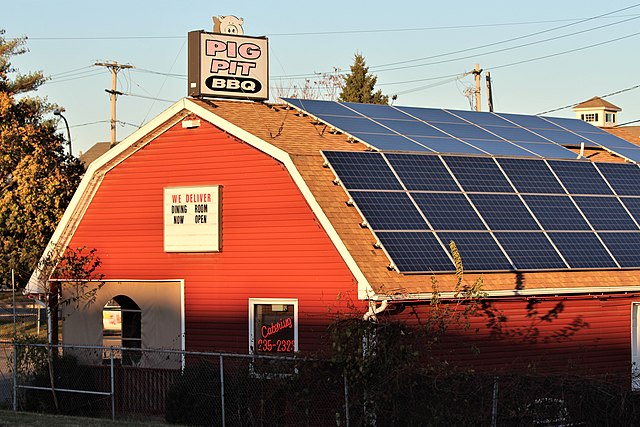Researchers simulated the operation of bifacial PV and reversible proton exchange membrane fuel cells in restaurants in five different US states. Taking into account the varying yields of bifacial PV, they found that the LCOE was only $0.029 per kWh.
An international research group has simulated the coupling of bifacial PV panels with proton exchange membrane (PEM) reversible fuel cells (RFC) to power commercial buildings.
The simulation was conducted at five locations in the United States: Tucson, Arizona; Los Angeles, California; Denver, Colo.; Dallas, Texas; and Minneapolis, Minnesota.
“One of the most surprising results of the study is the significant cost savings achieved by increasing bidirectional PV gain,” said corresponding author Ahmad Mayyas. pv magazine. “This improvement has led to a reduction in the levelized cost of electricity (LCOE) by 16%, the levelized cost of hydrogen (LCOH) by 14% and the levelized cost of storage (LCOS) by 13%. Another surprising insight is the system’s adaptability across a range of climates – from the arid conditions of Tucson to the colder environment of Minneapolis – demonstrating not only significant improvements in energy output, but also remarkable cost-efficiency across different geographic locations.
Energy demand data for the locations was obtained from the U.S. Department of Energy’s National Renewable Energy Laboratory (NREL), assuming full-service restaurants with average hourly demand of 20.33 kWh, 27.87 kWh, 116 .98 kWh, 46.62 kWh and 32.51 kWh. kWh in Dallas, Denver, Los Angeles, Minneapolis and Tucson, respectively. Weather data for these regions were obtained from the National Solar Radiation Database, which shows that global horizontal irradiation (GHI) ranges from 1,400 kWh/kWp/year to 2,100 kWh/kWp/year.
The bifacial PV system was simulated under different conditions of back gain of 0%, 5%, 10% and 20%. It was assumed that the system would power the building, while the excess energy would be used to produce hydrogen or sell it to the grid when the hydrogen tank is full. When there is no solar energy, the reversible fuel cells come into action and produce electricity to meet the restaurant’s load. When the hydrogen runs out, electricity is supplied by the electricity grid.
“The optimal dimensions of the network search optimization technique were identified by carefully considering factors such as network impact, capital costs and adherence to net metering principles,” the academics explained. “The primary goal of determining the optimal size was to minimize excess energy exports to the grid. Sizes greater than optimal could potentially lead to unnecessary pressure on the electricity grid and increase capital costs.”
According to the optimization, the PV system had a capacity of 300 kW in Tucson, 1,200 kW in Los Angeles, 350 kW in Denver, 300 kW in Dallas and 900 kW in Minneapolis. The electrolyzer/fuel cell size was 200/84.5 kW, 700/296.1 kW, 200/84.5 kW, 200/84.5 kW, and 400/169.2 kW, respectively. The inverter sizes were 100 kW in Tucson, 300 kW in Los Angeles, 100 kW in Dallas and Denver, and 200 kW in Minneapolis. The dimensions of the hydrogen tanks were 150 kg, 500 kg, 150 kg and 250 kg respectively.
“The increase in PV profits emerged as a powerful lever for optimizing economic efficiency. In the Tucson area, which has a high GHI, the LCOE of PV systems is $0.034 per kWh for PV systems without bifacial gain,” the researchers said. “However, with a 20% bifacial PV gain, the LCOE drops to $0.029 per kWh. Similarly, in Minneapolis, which has the lowest GHI, the LCOE for standard PV systems is $0.051 per kWh, which equates to $0.043 per kWh with two-sided gains.”
Furthermore, the researchers found that there is a reduction of $0.6 per kg for the LCOH, with greater PV gains in all regions. “For the LCOS there is a decrease of $0.06 per kWh, and the total system LCOE shows a decrease of at least $0.02 per kWh in every region analyzed,” they also explained.
Their findings were presented in “Harvesting energy horizons: bifacial PV and reversible fuel cells unite for sustainable building solutions”, published in the International Journal of Hydrogen Energy. Scientists from the United States’ Lawrence Berkeley National Laboratory, the US Army Corps of Engineers and the United Arab Emirates’ Khalifa University of Science and Technology conducted the research.
This content is copyrighted and may not be reused. If you would like to collaborate with us and reuse some of our content, please contact: editors@pv-magazine.com.


